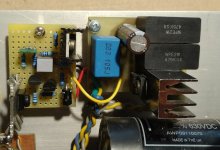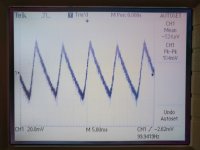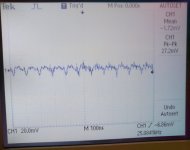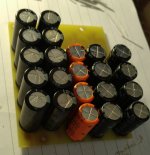Only the expensives one since the kapal and aboves. The basic mkp ones are not good to my tastes.
I currently have three PP capacitors on the signal path, of which I consider only one critical because it has a large voltage difference on it (90V on tube buffer output). There are many articles of the proper use of capacitors, and the point is that the voltage difference on them is as small as possible in order to reduce their influence in audio path.
Even UKZ that some people don't like have their own pdf on how to use them and why, simple ds doesn't have that information.Normally not in the signal path, there are other series for that.
OS-CON are also excellent, but you need to know how to use them in the right place. In my opinion, they are excellent for a DAC, starting with the regulator itself and beyond.
Let's not forget that the most important thing is our impression, so sometimes all pdf, measurements and papers fall into the water.
Even UKZ that some people don't like have their own pdf on how to use them and why, simple ds doesn't have that information.Normally not in the signal path, there are other series for that.
OS-CON are also excellent, but you need to know how to use them in the right place. In my opinion, they are excellent for a DAC, starting with the regulator itself and beyond.
Let's not forget that the most important thing is our impression, so sometimes all pdf, measurements and papers fall into the water.
This is already a tradition. ZenMod and his Papa (HAL 9000) use ELNA SILMIC II RFS coupling caps in the preamplifier and amplifier that I have. So I have them in my entire chain now.😉@mikorist, if you like it, what do you care what I and the others say.
Another interesting thing is that it is obvious in my system (DAC and amp) that changing some elements away from the audio path changes the sound without anyone touching the capacitors, there were many other things that can affect the sound much more than the capacitors themselves.
But capacitors are the easiest to change😉
But capacitors are the easiest to change😉
Then Enter the realm of professional gamers from manufacturers like Isabellenhütte or Susumu...etc ....not HiFi Collective hifi kids😀Resistors that determine output has the most effect on the sound.
https://www.isabellenhuette.de/en/precision-and-power-resistors
https://eu.mouser.com/ProductDetail/Susumu/RGA2012P-4991-B-T1?qs=bZr6mbWTK5kLXwhvqm/kIA==
Low ppm, high operating temperature and excellent tolerance.
Since the sum is of a temperature nature, at room temperatures it has a significantly lower sum than standard resistors of the same size and similar thin film technology
But it costs €5 peace🤣
I would not really agree, resistors play a minor role as well as capacitors, there are much more important things that affect the sound.Resistors that determine output has the most effect on the sound.
And you also need to change the resistors on the SS3601, also with Susumu, for this to have a full effect.🤣
Plesa do elaborate.I would not really agree, resistors play a minor role as well as capacitors, there are much more important things that affect the sound.
Miflex replaced Russian FT-3 teflons and then came Duelund.😉Miflex are very good PP audio capacitors
There's nothing to elaborate here, it's very simple, for example I only use RN60 or Vishay MELF resistors and I don't bother with them at all, I know they are good and low noise and that's it.Plesa do elaborate.
Should I put something else instead of RN60? Is that effort worth it?
This difference can hardly be measured with any instrument other than the ear, which is again subjective.
It was much more worthwhile that I put a new 180V low-noise reference in the regulator for ECC88 in the output of my DAC . This can be measured and you can really hear the difference in the sound, much more than if I had changed resistors and wasted days searching for the holy grail of resistors or capacitors. Let's not forget what I wrote in the previous post, you need to know the parts and decide where to put them, that's already more than half the job.
Afterwards, it's easy to fine-tune it as you like, but the most important thing is that big things usually affect the sound, such as power supplies, regulators, type of I/V stage or as a concrete example replacing CS8416 with DIR9001, which is very audible due to the smaller jitter of DIR9001.
There are many examples, especially in the DAC, which combines digital and analog components so the game never ends. 😉
Attachments
PSU 2 not only for AD1862
PSU 2 is based on LT1963A/LT3015 LDO regulators.
Why I chose these regulators? Letting DIY people only on 78/79 regulators would not be fair, so I was searching and found an inspiration in this test:
A-comparative-overview-of-power-supply-regulator-designs-with-listening-tests
In the basic configuration, components are set to output the +/-5VD and +/-12VA for AD1862 DAC.
These regulators are adjustable and are set via resistors and fine tuned using a trimmer.
Again, the output power and heatsink is a DIY question, but since the AD1862 DAC consumption is small, it should go without heatsink
PCB size is 75x150mm and is universal - you can solder components for any other DAC voltages.
It can be cheaply ordered from jlcpcb or any other PCB manufacturer.
(it was not tested at the time of writing this post)
Example list of components (copied from BOM picture, except resistors)
mouser:
603-FMP300FRF73-1R
505-MKP20.01/400/5
R79IC3100Z340J, 505-MKP2D031001FJO00
667-EEU-FR1E101
667-EEU-FR1V271L
647-LKG1V682MESYAK
72-T93YB-2K
72-T93YB-100K, 594-64Y503
72-T93YB-100K
72-T93YB-200K
604-L483GDT
511-1N5822
863-1N4007G
584-LT1963AET#PBF
584-LT3015ET#PBF
534-4628
576-0216001.MXR20SPP
651-1729128
651-1729131
ebay: 233823483402, 233670142926
Because Tube I/V is used, +/-12VA is not needed. I'm converting a DAC into a network streamer, and since I need to supply 5V to the 8.8" Display, I made a plan to change the resistance of the +/-12VA circuit to +/-5VD. Power consumption during actual operation on the 8.8" Display. confirmed. 3.3Watt (660mA). I'm currently using the default heatsink and would like to know if I need to size the heatsink larger.
Regarding the dac and psu. Did someone tried commercial discrete 3 pin regulator for the 12v & 5v?
The problem would lie in the distance. Im tinking of a small diy pcb for these regs to plug in the dac psu connections and feed this with filterd dc from a separate regulated board.
Wast of time?
The problem would lie in the distance. Im tinking of a small diy pcb for these regs to plug in the dac psu connections and feed this with filterd dc from a separate regulated board.
Wast of time?
Most people will just make a miro dak + JL USBtoI2s, Amanero ... Making tube I/V stage or selecting the SPDIF input is another matter just like OP roaling. How many tube I/V stage can you make? 😉There's nothing to elaborate here, it's very simple, for example I only use RN60 or Vishay MELF resistors and I don't bother with them at all, I know they are good and low noise and that's it.
Should I put something else instead of RN60? Is that effort worth it?
This difference can hardly be measured with any instrument other than the ear, which is again subjective.
It was much more worthwhile that I put a new 180V low-noise reference in the regulator for ECC88 in the output of my DAC . This can be measured and you can really hear the difference in the sound, much more than if I had changed resistors and wasted days searching for the holy grail of resistors or capacitors. Let's not forget what I wrote in the previous post, you need to know the parts and decide where to put them, that's already more than half the job.
Afterwards, it's easy to fine-tune it as you like, but the most important thing is that big things usually affect the sound, such as power supplies, regulators, type of I/V stage or as a concrete example replacing CS8416 with DIR9001, which is very audible due to the smaller jitter of DIR9001.
There are many examples, especially in the DAC, which combines digital and analog components so the game never ends. 😉
A good resistor is a good resistor, but for most who won't try another IV stage or input, in addition to replacing the OP, I suggest they try a couple of different resistors. Maybe they can hear the difference.
On your Miro AD1865, we heard that those I/V resistors sound a lot different. The same goes for the Pavouk modest DAC with passive I/V and a tube stage.
I just gave an example with tubes and DIR9001, but as I wrote, the game never ends.Most people will just make a miro dak + JL USBtoI2s, Amanero ... Making tube I/V stage or selecting the SPDIF input is another matter just like OP roaling. How many tube I/V stage can you make? 😉
A good resistor is a good resistor, but for most who won't try another IV stage or input, in addition to replacing the OP, I suggest they try a couple of different resistors. Maybe they can hear the difference.
For example, I would insert ADP7118/ADP7182 on miro's PCB instead of jumpers in the power supplies and keep the original power supply with LT3015/1963, which would then be pre-regulators or put a CRC filter in front of LT3015/1963. Below is an example after adding the CRCRCRC filter before ADM7151 in my DAC.
right now, with the tubes I have, I could make 4 sets of I/V stage 😉How many tube I/V stage can you make? 😉
Attachments
- Home
- Source & Line
- Digital Line Level
- DAC AD1862: Almost THT, I2S input, NOS, R-2R




